Disclaimer: This blog post contains affiliate links. If you make a purchase through these links, I may earn a small commission at no additional cost to you. Learn More. Thank you for supporting our garden community.
5 Vegetables You Didn’t Know Could Grow in Hanging Planters
When most people think of hanging planters, they imagine flowers. But if you’re smart about it, hanging planters can be used to grow fresh vegetables, especially if you’re short on space. Not every vegetable belongs in a hanging planter, though. You need plants that either trail naturally, stay compact, or have shallow roots. And I’ll introduce you to exactly that.
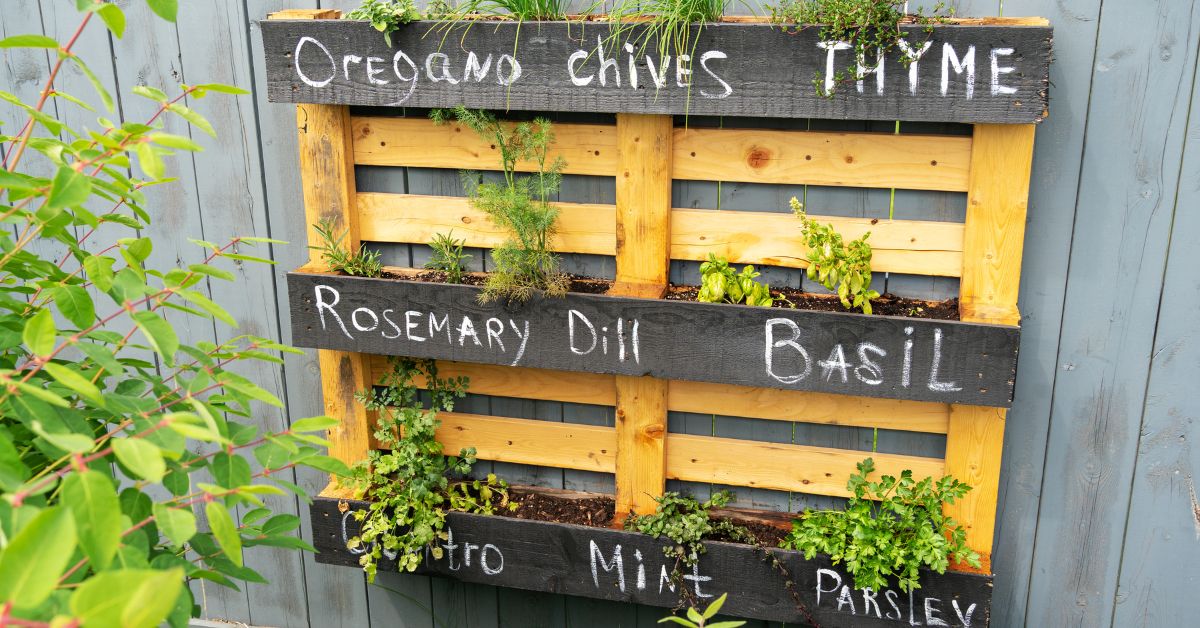
Vegetables to Grow in Hanging Planters
Whether you’re short on space or just want an aesthetic garden, hanging planters are the thing for you.
A lot of people don’t know that vegetables can actually be grown in hanging planters. They think that they are just for flowers.
But that couldn’t be further from the truth.
And let’s be honest: is there anything better than harvesting vegetables right from your porch?
Growing vegetables like this will multiply your growing space, allowing you to grow more food. And you’ll keep pests away from your precious food.
That being said, let’s get right into 5 vegetables you didn’t know could grow in hanging planters.
Products:
Save 10% on your first Burpee seed order using code BURPEE10
Why Grow Vegetables in Hanging Planters?
There are many reasons why we would want to grow vegetables in hanging planters. So here are a few of them:
- Saves Space: Hanging planters can be used on patios, balconies, porches, and other underused spaces on our properties. You are able to take advantage of these spaces to grow more food in your garden.
- Better Airflow: Because the plants are above the ground and hanging in the air, there is much more airflow around them. This reduces pests like slugs and aphids, and reduces the risk of diseases like powdery mildew. But that won’t stop every pest. I still highly recommend using this high-quality floating row cover to protect from all of those flying pests.
- Accessibility: You don’t have to bend over to the ground to harvest your vegetables in hanging planters. They’ll either be at eye level or by stretching out a little bit to reach them.
- Aesthetic Value: It’s also true that hanging planters are just beautiful. Even with vegetables, they provide a hanging plant look that can’t be achieved any other way.
Choosing the Right Hanging Planter
Not all hanging planters are created equally.
There are different materials for different planters, each with their own benefits. There’s plastic, terracotta, fabric, and metal planters.
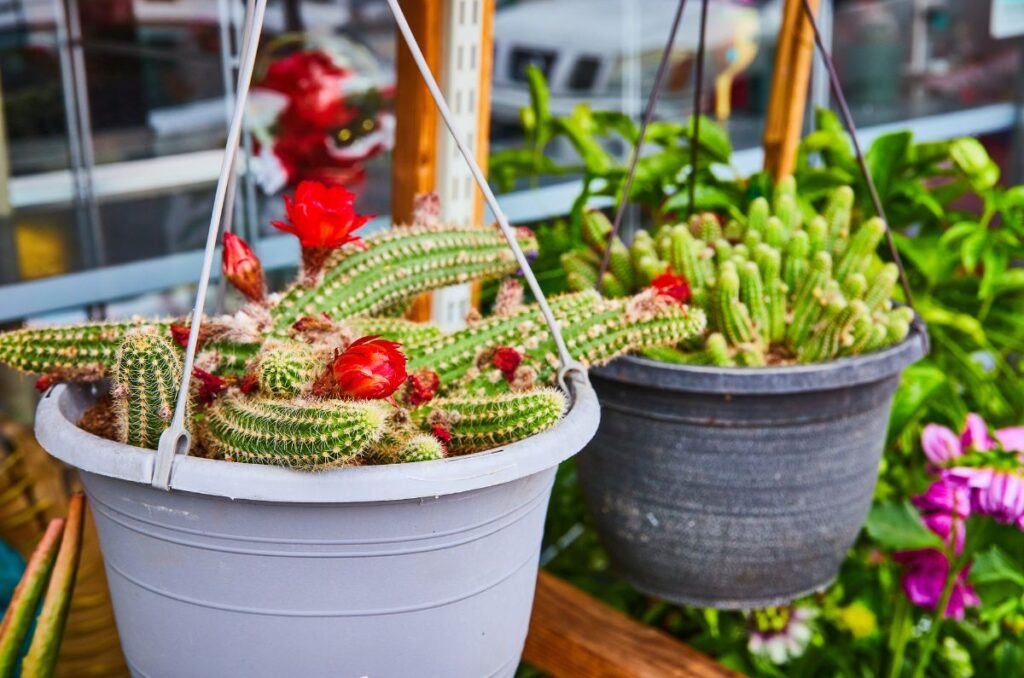
Personally, I like to use these plastic planters, simply because they’re cheaper. I don’t really worry about aesthetics when growing vegetables.
But if you do, then these terracotta planters would be better for you.
The best size for hanging planters is generally about 5 gallons, but you can use bigger or smaller if you need it for your plants.
But also know that the larger the pot, the heavier it will be. So if you’re not confident with the support, then don’t use a larger container.
5 gallon planters are generally a good size for most vegetables.
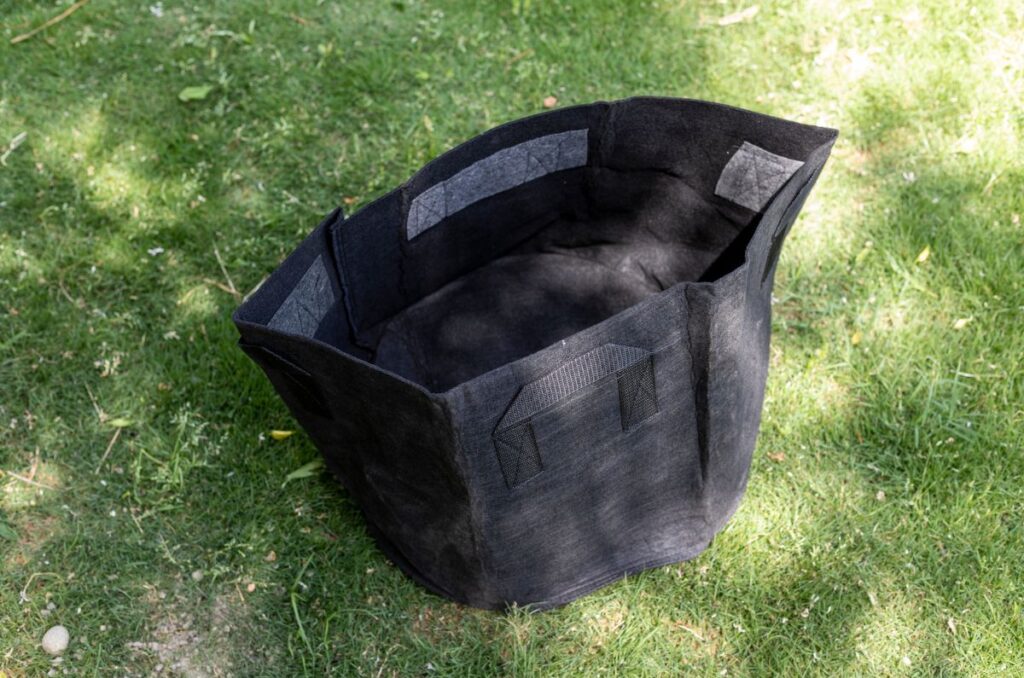
I also like to make my own hanging planters with grow bags. I’ll attach a strong string to the handles and attach that to my vertical support.
Because a lot of the time those hanging planters are expensive. So this helps me to save some money.
Another option for hanging planters is those ones that go on the railing of your porch or balcony. These are really easy to install and generally pretty sturdy.
Where to Hang Your Planters
It’s important to choose the right spot for your planters so they get enough sunlight and airflow.
Choose a place where the planters get at least 6-8 hours of direct sunlight every day.
Normally I might say that it doesn’t matter that much with containers, as you can move them throughout the day. But it’s basically impossible to move hanging planters with the sun.
So make sure the spot gets enough sunlight from the beginning. A lot of us have large trees or other plants in our yards, so choose an area away from these.
Additionally, the support system needs to be strong enough to support the weight of the containers with all the soil in them.
Something like a railing, overhang, fence, or the wall is perfect for attaching your planters. These supports are usually pretty sturdy.
If you live in an area where the fences were made cheaply, then maybe don’t do that cause they’ll fall over.
You can attach them to windowsills, pergolas, or arbors as well.
To sum it up, choose a spot with lots of sunlight and a sturdy support structure.
How to Attach Hanging Planters
How you attach a hanging planter depends on what type of planter you have.

For railing planters, most of them just slip right on the top. The ones that I have lean too much forward to the point that they’re almost diagonal.
So I’ve had to put a piece of wood between the planter and the railing to keep it straight and upright.
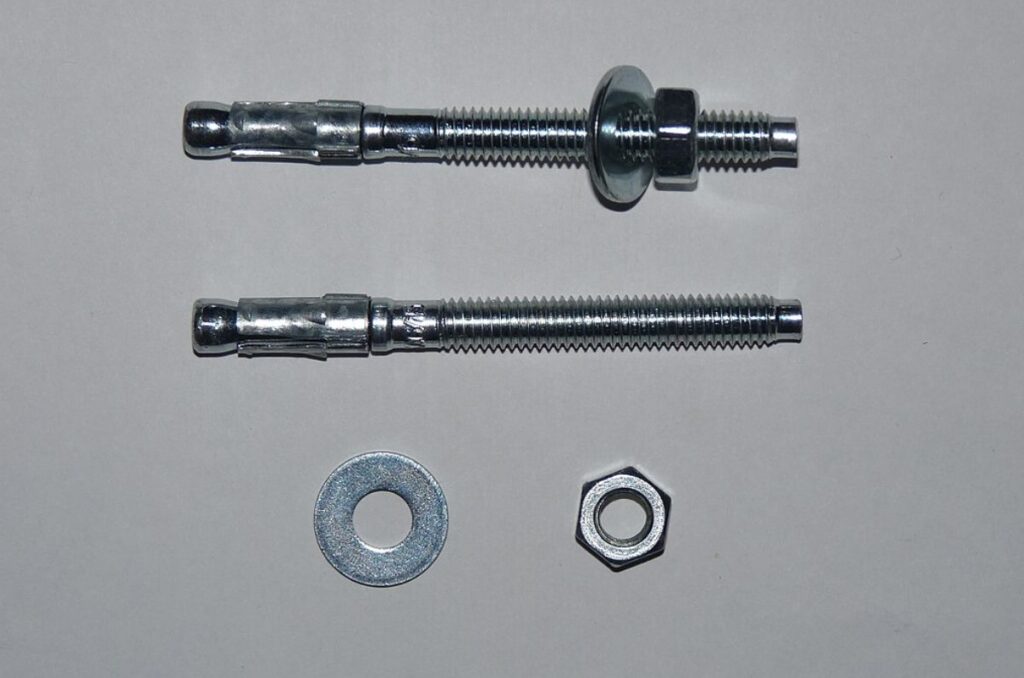
For ceilings and overhangs, you’ll need heavy-duty anchor bolts. These can attach right to your structure and you can hand your pots on them.
This also provides a built in trellis for plants like tomatoes and peas.
Don’t attach these kinds of hooks to drywall or old wood. It has to be sturdy.
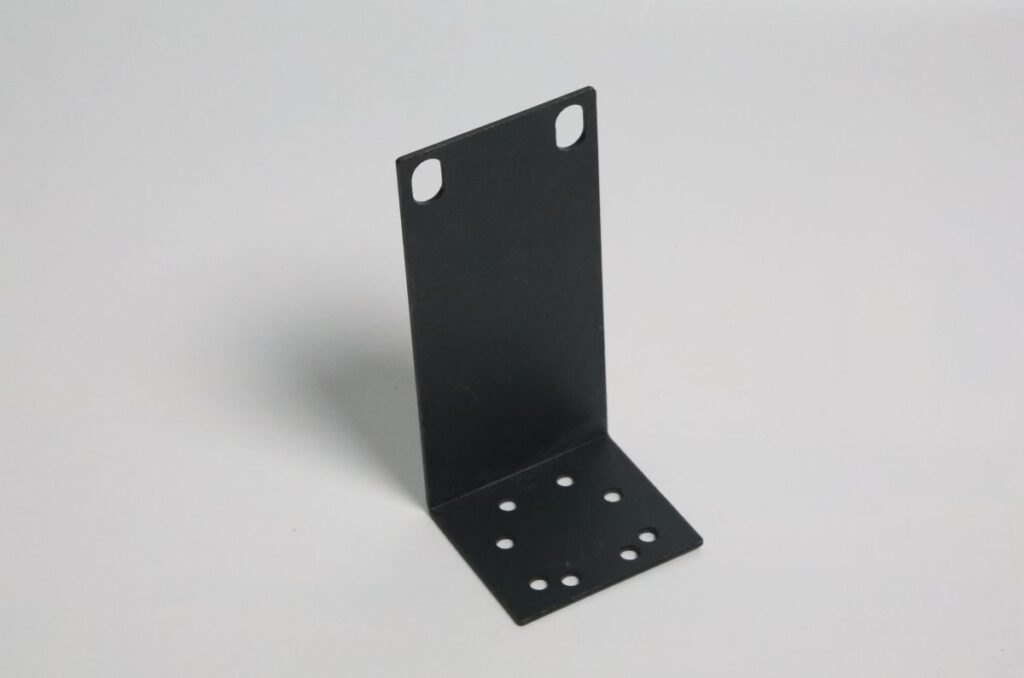
For walls or hanging planters for fences, you can use the same hooks or wall-mounted brackets. They work really well for fences because they’re usually pretty compact and effective.
These brackets allow you to hang any type of pot from your fence or wall.
Just make sure you have a strong hook on a strong support that can support the weight of your container full of wet soil and plants.
Make sure that the planters are not too high up, or else you won’t be able to water them. They should be at arm’s reach.
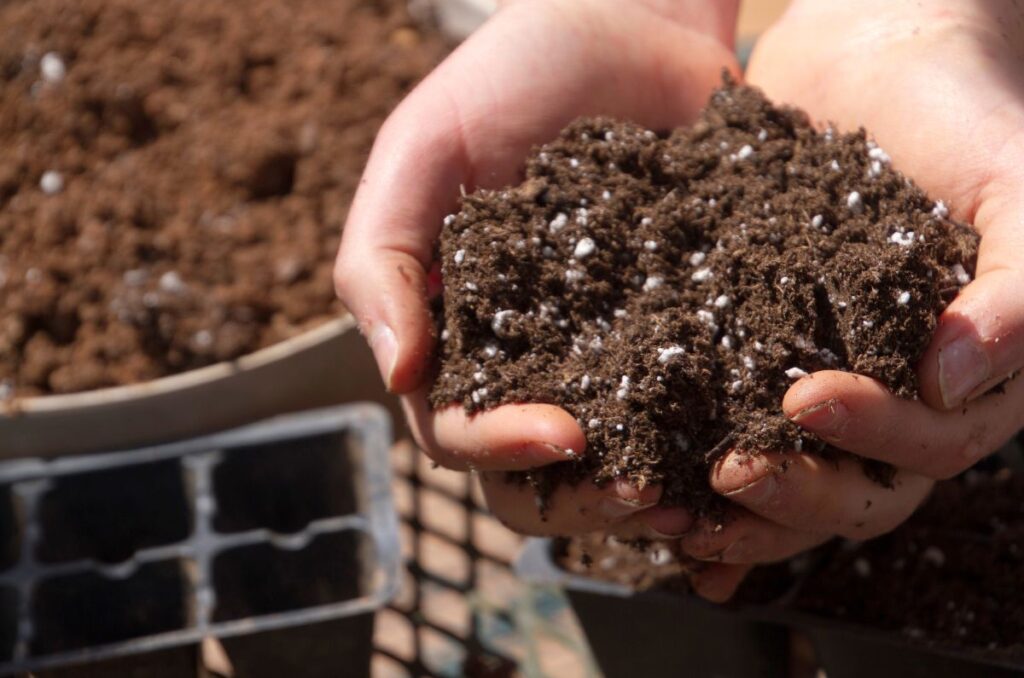
Preparing the Soil
With containers of any kind, you can’t just put regular old garden soil in there. It’s too heavy, meaning it’ll get compacted and reduce the amount of air, water, and nutrients your plants get.
This can be prevented by making the right soil mix.
A good container soil blend is usually 30-40% compost by volume, with the rest being high-quality potting soil.
This provides the water-retaining properties, some nutrients, and aeration.
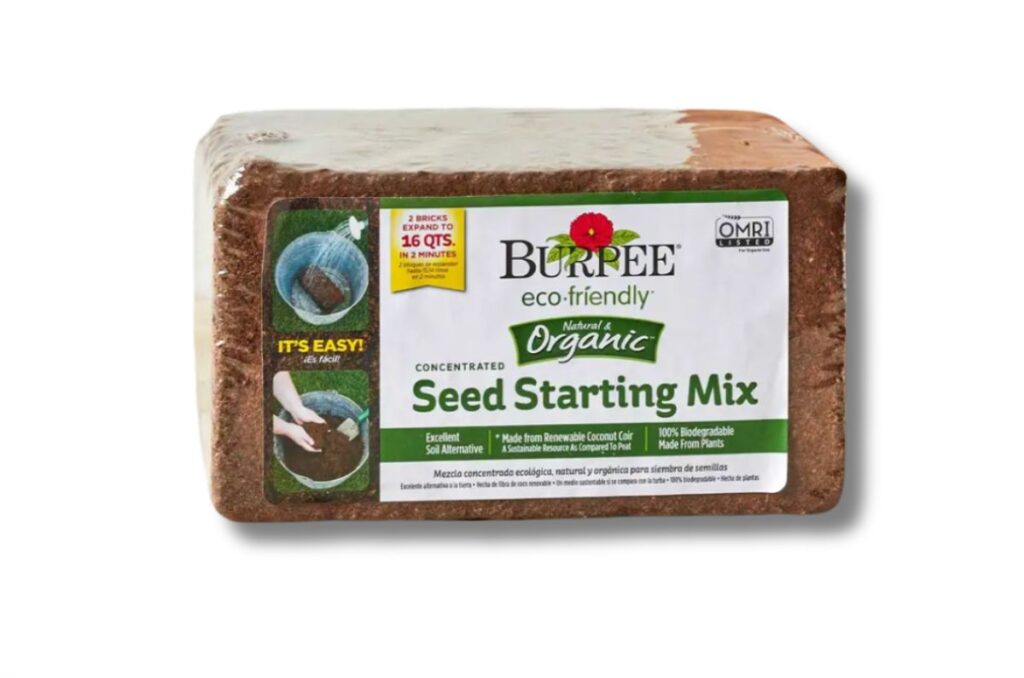
Some people like to add coco coir for water-retention as well. But I find that, even though it holds onto more water, it takes a long time to get rehydrated after being dry for a while.
That’s my experience, but you can try it if you want.
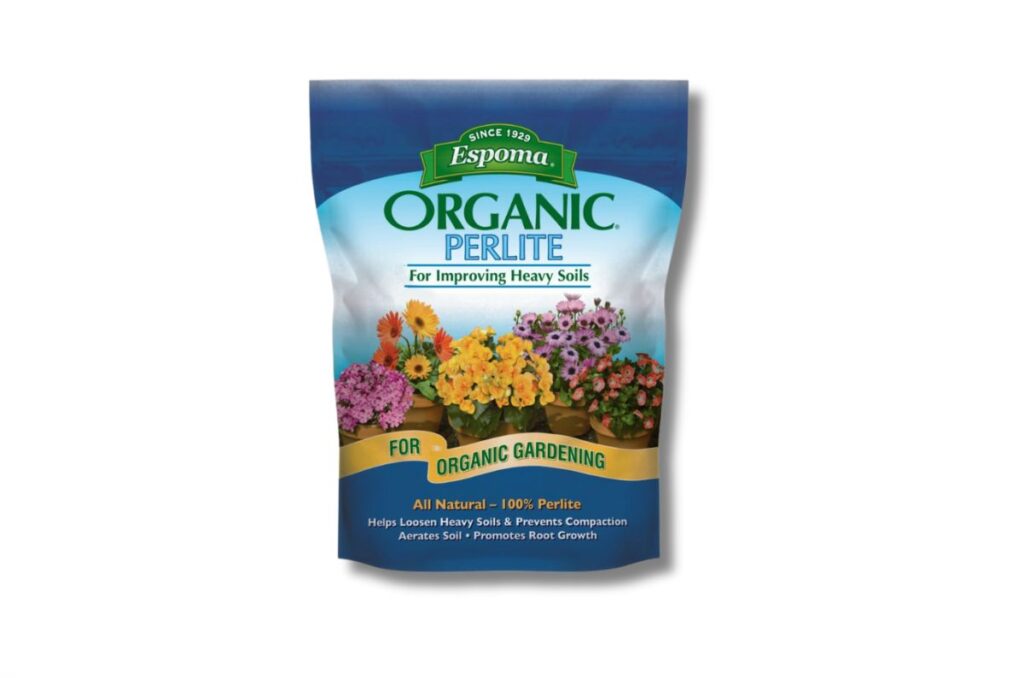
I also like to add a bunch of perlite to give even more aeration. It’ll help to prevent compaction when the soil gets wet and dry.
You can also add some granular organic fertilizer, but we’ll talk about that later.
What do You Put in the Bottom of a Hanging Planter?
depending on how deep your containers are, you might not want to fill them all the way with soil. Not only would this be expensive, but it’s also unnecessary. You don’t need all that soil down there.
Instead, you can fill the first few inches of the container with any organic matter you have lying around. Leaves, grass clippings, shredded paper, or unfinished compost are perfect.
This creates a hugelkultur-style container for your hanging planters.
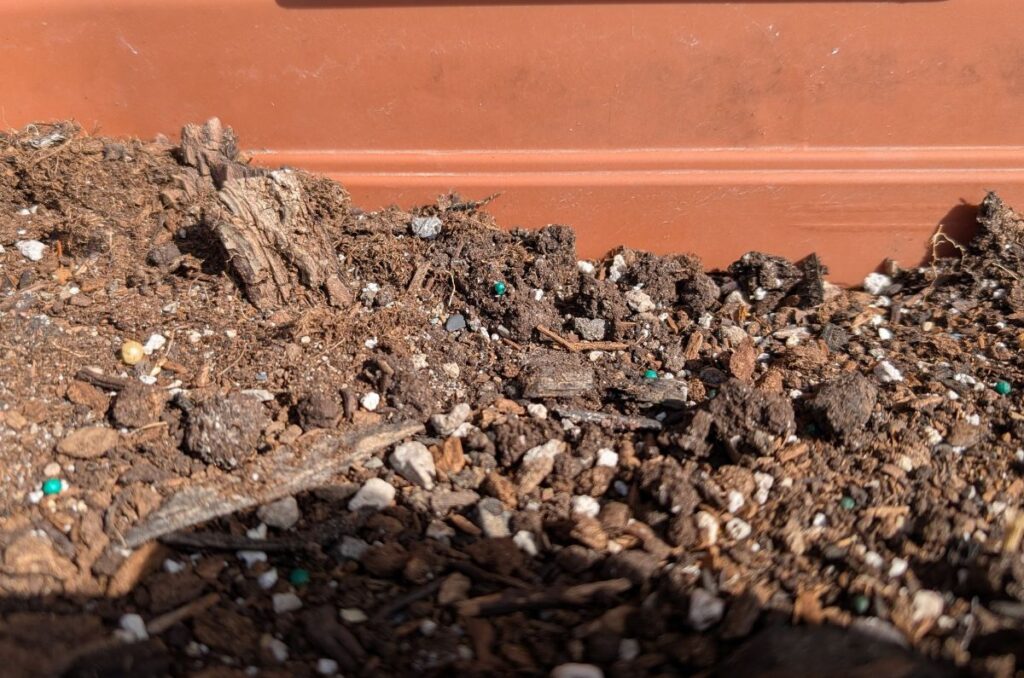
Watering Hanging Planters
You’ll notice that hanging planters dry out quickly, like super quickly. It’s kinda crazy, especially in the summer.
That being said, pay attention to the soil and make sure to water as often as you need it. You can check by sticking your finger in the soil up until your second knuckle.
If your finger tip is wet, then you don’t have to water. If your finger tip is dry, then you need to water.
During the summer, you might have to water some plants at least 2 times a day, depending on how hot it gets in your area.
Just make sure that the soil stays moist and your plants’ leaves are not drooping.
They have some self-watering planters on the market, but I’m not convinced they do anything. I guess you can fill up the bottom and water like that, but I don’t know.
If you’re curious about self-watering options, here’s a good one if you want to use it in your garden.
Fertilizing Hanging Planters
Fertilizing will be a little bit challenging because there’s hardly any life in your planter soil. It’s not raised beds or in-ground where there are tons of worms and microbes to break down organic matter.
That being said, you shouldn’t use a slow-release fertilizer like bone meal. These types of fertilizers release their nutrients over a longer period of time as they get broken down.
But since there’re barely any microorganisms in the soil, it basically won’t get broken down.
So you can put the fertilizer in there, but it won’t do anything for your plants.
Instead, I like to use a readily-available liquid fertilizer. You can dilute these with water and apply it to your planters every time you water them.
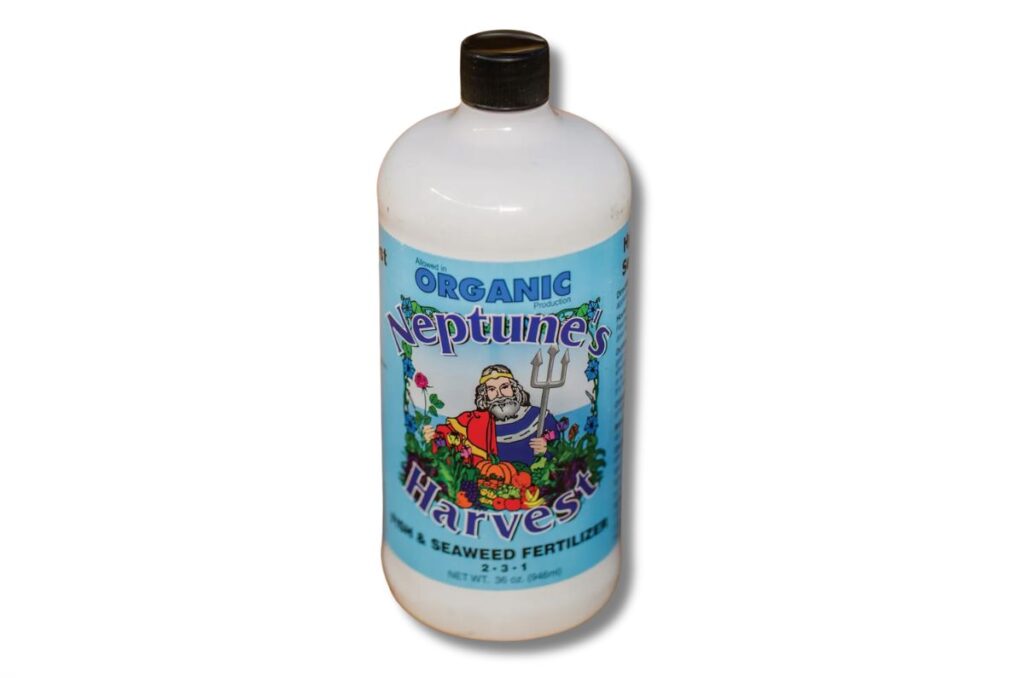
My favourite one is fish and seaweed fertilizer, which is an almost completely readily available liquid organic fertilizer.
It doesn’t need to be broken down any further to become bioavailable for your plants, so you don’t have to worry about that.
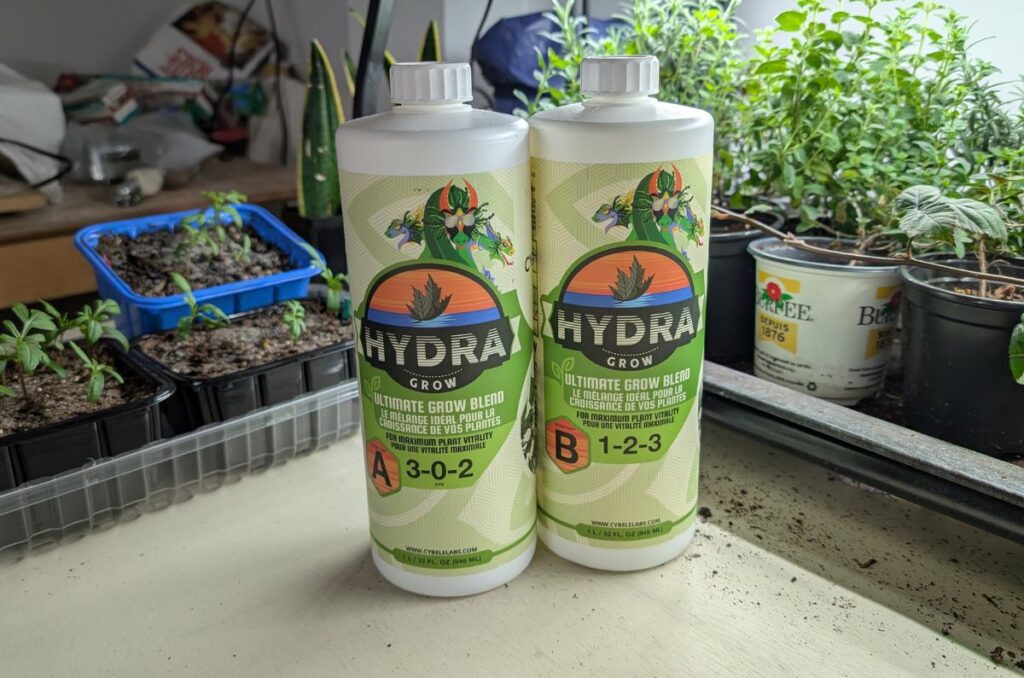
Another good one that I like to use is called HydraGarden. It’s a Canadian-made organic liquid fertilizer company. I use their products all the time in my YouTube videos.
I’m not affiliated with HydraGarden in any way, I just really like their fertilizers.
So dilute it with some water and use that every time you water your hanging planters. This will keep them happy and healthy through the growing season.
5 Vegetables to Grow in Hanging Planters
Now let’s get into our list of 5 vegetables you didn’t know could grow in hanging planters. And I won’t just be listing the obvious ones.
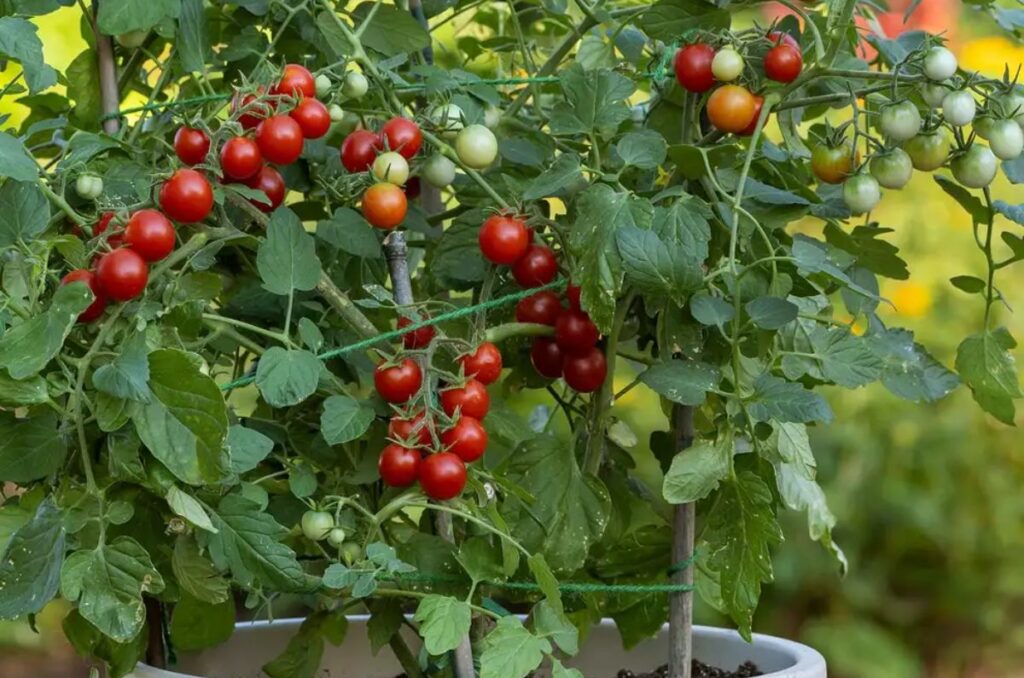
1. Tomatoes
Tomatoes are great for growing in hanging planters. But it’s better to grow varieties with smaller fruits compared to those with large fruits.
This is because it takes much more space, sun, energy, and nutrients to produce large tomatoes. And you probably won’t get that from a hanging planter.
Additionally, tomatoes can be grown vertically with a simple trellis, or you can let them trail down the side of the planter.
Trellising is because there’s already a strong string holding the container. You can make offshoots from that string and tie your tomato plants to it.
Or you can grow your tomatoes upside down. This is good if you have your containers really close to the roof and the tomatoes have nowhere to grow. So grow them upside down instead.
Make sure to keep up with watering, fertilizing, and pruning. Tomatoes can be fertilizes every time you water during the summer with a liquid organic fertilizer.
Here are some of my favourite varieties for hanging planters:
- Veranda Red: This variety is a very compact determinate tomato that grows to only 2 feet tall. The small cherry fruits are ready to harvest in 55-60 days.
- Sweetheart of the Patio: Another compact determinate tomato that’s perfect for the patio. This small plant only grows to 2-3 feet. They’re ready to harvest in 68 days.
- Yellow Current: This indeterminate tomato variety produces tons of small yellow cherry tomatoes the size of a currant. They’re ready to harvest in 60 days.
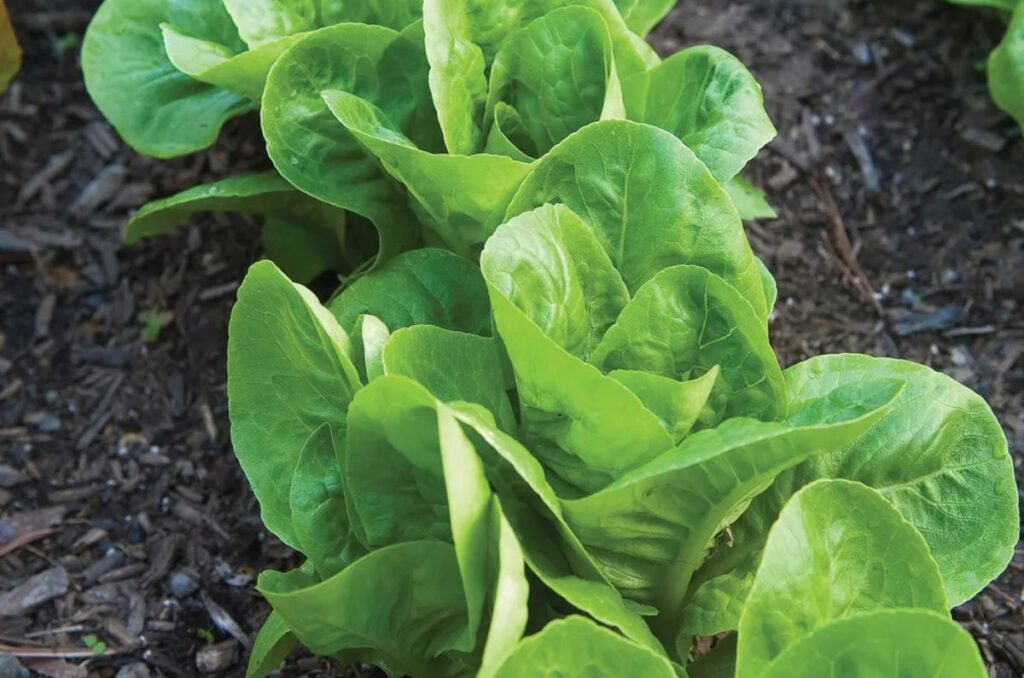
2. Lettuce
Lettuce is a great plant to grow in hanging planters, especially in windowsills and balconies. They don’t need tons of sunlight or nutrients to produce a good harvest.
They can grow well with only 4 hours of direct sunlight per day, and they actually prefer it when it gets really hot. In the summer, lettuce can bolt because of the intense heat.
Morning sun and afternoon shade is perfect for growing lettuce. Giving them some shade can actually help their growth.
To further prevent bolting, try succession planting. This is where you continue planting lettuce seeds every week to ensure you have a continual harvest throughout the growing season.
Additionally, lettuce plants have very shallow root systems, meaning they don’t need much container space to grow well.
And they grow very low to the ground, typically about 6-8 inches tall. So you don’t need a trellis or much vertical space to get a good harvest.
Make sure the soil is kept moist because lettuce really doesn’t like to be dry. The leaves will wilt and turn crispy if you let them dry out too much.
Keep your plants well-watered and you’ll have a good harvest.
Here are some of my favourite lettuce varieties for hanging planters:
- Little Gem: This lettuce produces a personal-sized romaine head that’s perfect for a small salad. It grows to about 10 inches and is ready to harvest in 50-55 days.
- Hamberg Hybrid: This variety is a hybrid between romaine and iceberg, producing a small, flavourful, and crunchy head perfect for pots. Ready to harvest in 70 days.
- Salad Bowl: This looseleaf lettuce variety is tender and crisp, and perfect for growing in containers and hanging planters. Ready to harvest in 45 days.
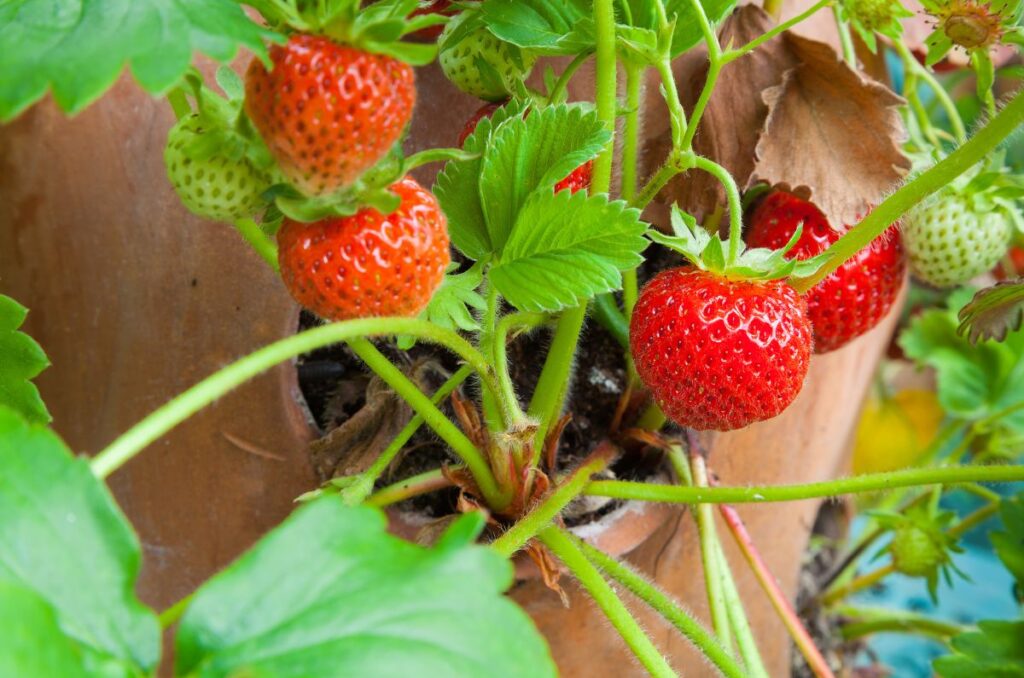
3. Strawberries
Yes, strawberries are a fruit. Yes, I included them on my list.
They’re so common in vegetable gardens that they technically count as vegetables in this case.
I like growing strawberries from bare-root plants because they’re cheaper and establish quicker than potted plants.
Strawberries need lots of sun to produce a ton of berries. 6-8 hours of direct sunlight is ideal for a good harvest. Shade during the day can slow down production.
They’re fairly shallow-rooted, like lettuce, meaning they don’t need much root space to grow well. A normal-sized hanging planter is perfect for strawberries.
They also don’t grow vertically, they usually only grow to 12 inches tall. They’re runners have more of a trailing growth habit where they cascade over the container.
Make sure to keep up with watering and fertilizer. Those juicy berries are very demanding, so use a high phosphorus and potassium fertilizer.
Phosphorus and potassium promotes flower and fruit production. My favourite one is bone meal.
The best hanging planters for strawberries are those that are about 6 inches deep. Like I said, they don’t need much root space.
Here are some of my favourite varieties:
- Ruby Ann: The perfect variety for hanging baskets. It produces beautiful ornamental flowers and tons of cascading red fruits.
- Albion: This is a classic everbearing strawberry variety that just keeps producing juicy and delicious berries. It’s resistant to verticillium wilt and crown rot.
- Seascape: Another classic variety that produces a ton of berries in almost any garden soil. The berries are very large, sweet, and produce through all seasons.
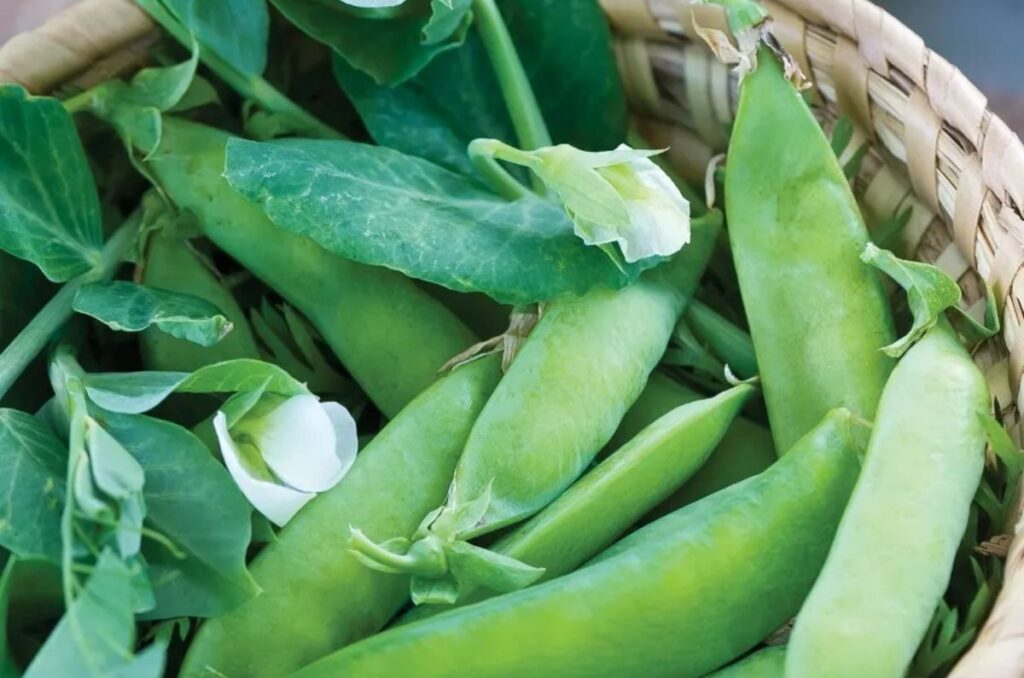
4. Peas
Another perfect vegetable to grow in hanging baskets are peas. There are lots of compact varieties that don’t take up much space.
They need full sun and lots of water to produce a good harvest, so make sure to give them that.
The good thing is that peas, like beans, are nitrogen-fixers, meaning they take nitrogen from the atmosphere and convert it to a usable form in the soil.
Because of this, peas actually don’t need much fertilizer. They definitely don’t need any supplemental nitrogen. Some good compost will do most of the fertilization.
If you want to grow a vining variety, then you can attach a trellis to the vertical supports of the hanging planter. Or you can let the plants trail and cascade down the container.
Or you can choose from one of the many dwarf varieties that only grow between 1 and 3 feet tall.
Here are some of my favourite peas for hanging planters:
- Peas-in-a-Pot: This variety was specifically bred for containers and small spaces. These tiny 10 inch plants mature in 60-65 days.
- Snowbird: These straight and early-producing peas grow to only 16-18 inches tall. Ready to harvest in 58 days.
- Blue Bantam Dwarf: This Burpee-exclusive variety takes a little bit longer to mature but is well worth the wait. Excellent-tasting peas are ready to harvest in 77-80 days.
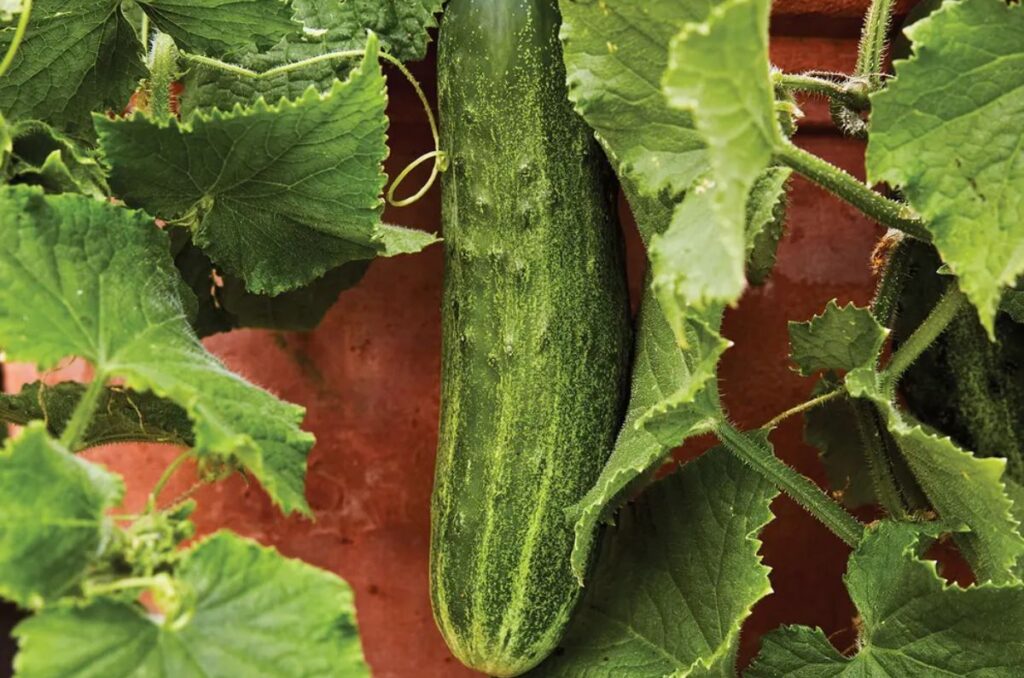
5. Cucumbers
Cucumbers are a little bit more challenging to grow in hanging planters. They’re very demanding in terms of their care and it can be difficult to get a good harvest.
That being said, you have to keep up with watering, fertilizing, and pruning.
Cucumber leaves are very large and they need a lot of water to stay happy. Without water, you’ll notice the leaves will start to droop.
They droop naturally when it gets hot, but if they stay wilted even when the sun passes, then you know you have to water them.
As for fertilizing, they’re heavy feeders, meaning they need a lot of nutrients to produce well. Fertilize them every time you water.
For pruning, it’s essential not to let the plants get too out of control. Or else they’ll spread everywhere, produce a bunch of leaves and flowers, and give small fruits.
Instead, leave one main branch to grow and produce. This branch can be trellised along the hanging planter support, or it can trail down the side of the container.
For dwarf varieties, they can easily grow upright or cascading down the side.
Here are some of my favourite hanging planter cucumbers:
- Bush Champion: A classic variety that takes up a third of the regular cucumber growing space. Vines are 24 inches long and ready to harvest in 55 days.
- Picklebush: Another Burpee-bred variety that produces 4.5 inch long fruits that are perfect for pickling. The vines are only 24 inches long and mature in 52 days.
- Spacemaster: This variety produces short and hardy vines that are only 26 inches long. It’s resistant to cucumber mosaic virus and is ready to harvest in 56 days.
Frequently Asked Questions
The best thing to stop soil from pouring out is landscape fabric. It lets air and water through, but soil can’t get through those tiny holes.
Even More Gardening Ideas
Here are a few more posts to get the ball rolling in your garden!
- The Best Cucumber Fertilizer Tricks
- How to Use Manure in the Garden
- Stop Blossom End Rot Easily With These Tips
If you liked this article, make sure to share it with your friends and family members who are also looking to sharpen their gardening skills. Also, consider signing up for our email newsletter; don’t worry, we won’t spam you, just fresh gardening ideas every week!
If you want to learn more about vegetable gardening, make sure to check out what I’m doing on Facebook, YouTube, and Pinterest.
Pin this post for later:
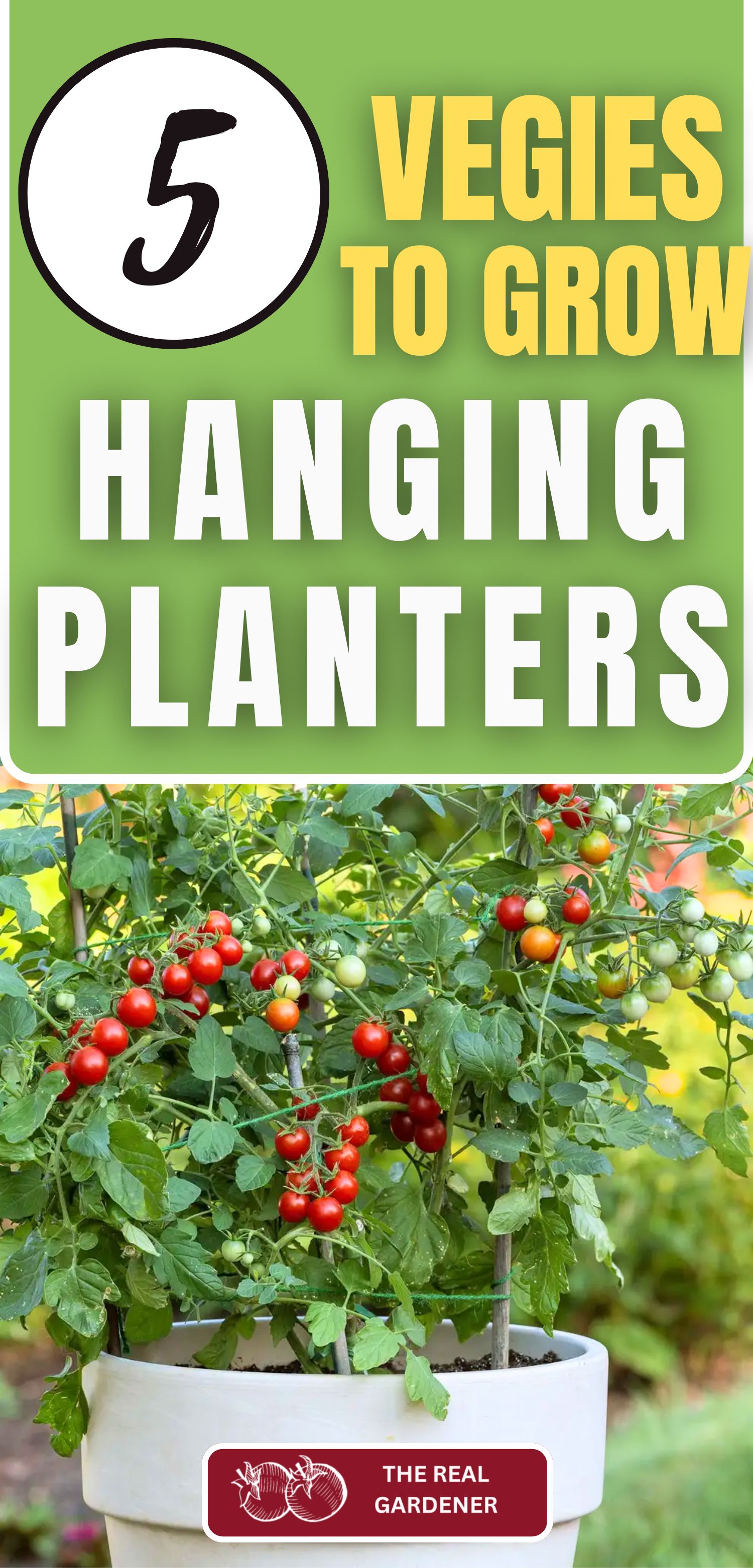
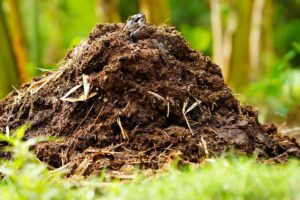
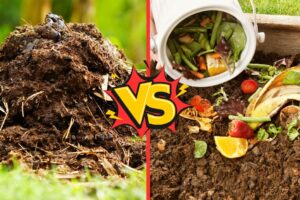
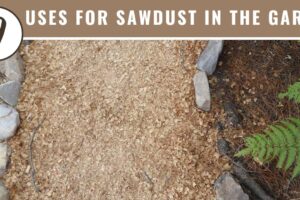
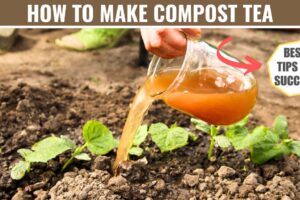
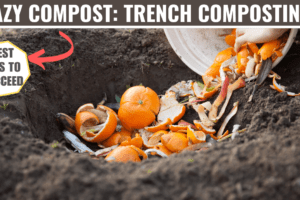
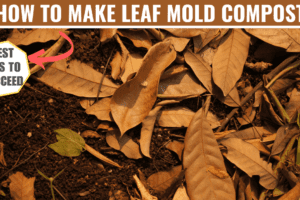
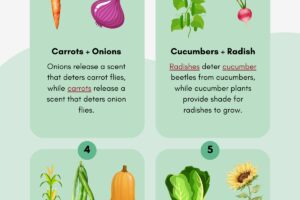
Leave a Reply